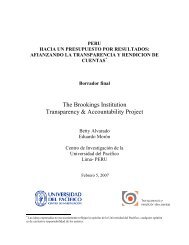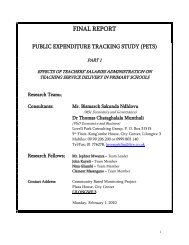Provider Purchasing and Contracting for Health Services_The Case
Provider Purchasing and Contracting for Health Services_The Case
Provider Purchasing and Contracting for Health Services_The Case
Create successful ePaper yourself
Turn your PDF publications into a flip-book with our unique Google optimized e-Paper software.
Policy implications <strong>and</strong> recommendations<br />
Contractual arrangements: <strong>The</strong>re is a need to develop a framework in which a clear legal <strong>and</strong><br />
administrative separation exists between providers <strong>and</strong> purchasers. This is essential to<br />
facilitate accountability among the purchasers <strong>and</strong> providers.<br />
Paying providers: <strong>The</strong> system governing the budgeting, planning, <strong>and</strong> reporting needs of the<br />
contractual arrangement has to be integrated <strong>for</strong> purposes of service <strong>and</strong> management<br />
per<strong>for</strong>mance evaluation. Ultimately, this should <strong>for</strong>m the basis <strong>for</strong> paying providers.<br />
Development of policy guidelines: <strong>The</strong> private sector in Zambia had grown rapidly since<br />
re<strong>for</strong>ms were implemented in 1991–1992. However, there is no legal <strong>and</strong> policy plat<strong>for</strong>m that<br />
provides <strong>for</strong> collaboration between the government <strong>and</strong> private <strong>for</strong>-profit providers.<br />
Considering the critical role that the private providers are playing, it is important that the<br />
government, together with the private providers, come up with a policy to guide collaboration<br />
<strong>and</strong> regulation.<br />
Quality assurance <strong>and</strong> accreditation: All <strong>for</strong>ms of contracting—public to public <strong>and</strong> public<br />
to private—were intended to be overseen by the regulation of minimum st<strong>and</strong>ards that would<br />
be the benchmark <strong>for</strong> quality assurance. <strong>The</strong>se st<strong>and</strong>ards would be used to assess contracted<br />
institutions, which would then be graded or accredited on the basis of the level of quality <strong>for</strong><br />
funding <strong>and</strong> determination of the type of services the institutions or districts were able to<br />
provide. It is recommended that regulatory authorities utilize this important mechanism,<br />
which has not been used so far.<br />
Inventory of existing competencies in the private sector: According to the National <strong>Health</strong><br />
Strategic Plan 2006–2010, the government is not aware of the services that the private sector<br />
provides that could <strong>for</strong>m the basis of contracting or even partnerships. Thus, there is a need to<br />
undertake an inventory of the existing services <strong>and</strong> competencies in the private sector <strong>and</strong><br />
ensure that District <strong>Health</strong> Management Teams <strong>and</strong> Provincial <strong>Health</strong> Offices include the<br />
activities <strong>and</strong> programs of the private <strong>for</strong>-profit providers in the district plans <strong>and</strong> eventually<br />
national plans.<br />
Adequate funding of the fund holders: <strong>Contracting</strong>-out is largely constrained by inadequate<br />
funding as the fund holders may not refer patients to the private sector providers that require<br />
immediate payments. If contracting-out is to be considered, there is a need to adequately fund<br />
the providers or indeed establish an insurance system that can facilitate timely <strong>and</strong> adequate<br />
resource flow to enable providers deliver quality service.<br />
Autonomy of providers/fund holders: <strong>The</strong> study shows that the contracting-in model based on<br />
the referral system can easily be extended to the private <strong>for</strong>-profit providers if only the fund<br />
holders are adequately financed <strong>and</strong> given the autonomy to purchase services strategically.<br />
Reliable funding <strong>and</strong> autonomy could give them the leverage needed to effectively negotiate<br />
with private <strong>for</strong>-profit providers <strong>and</strong> contract with them <strong>for</strong> services. Reducing the risk of<br />
default to the private sector can encourage it to take up contracts from semi-autonomous<br />
government fund holders by scaling up private sector participation.<br />
60
















